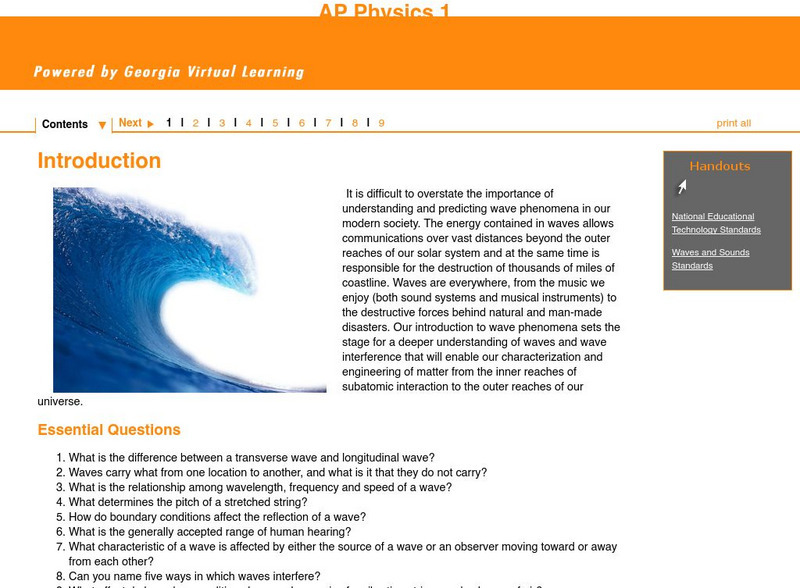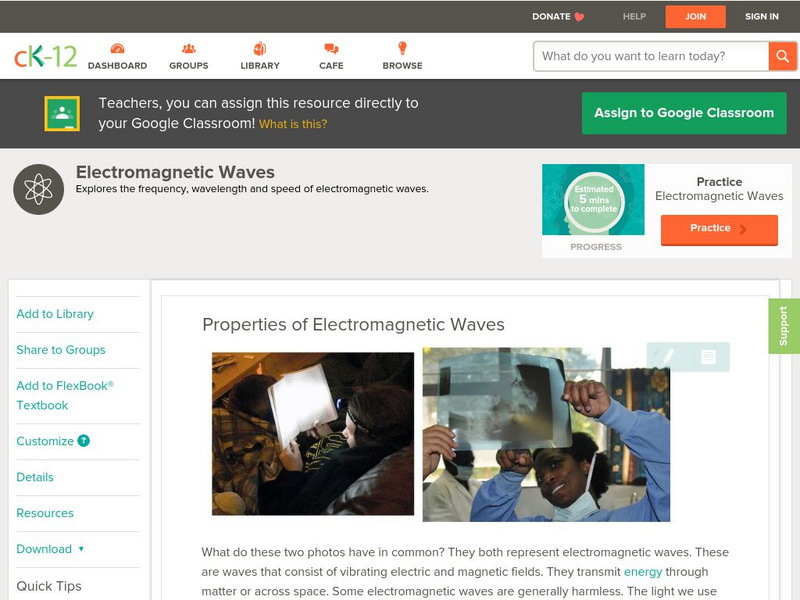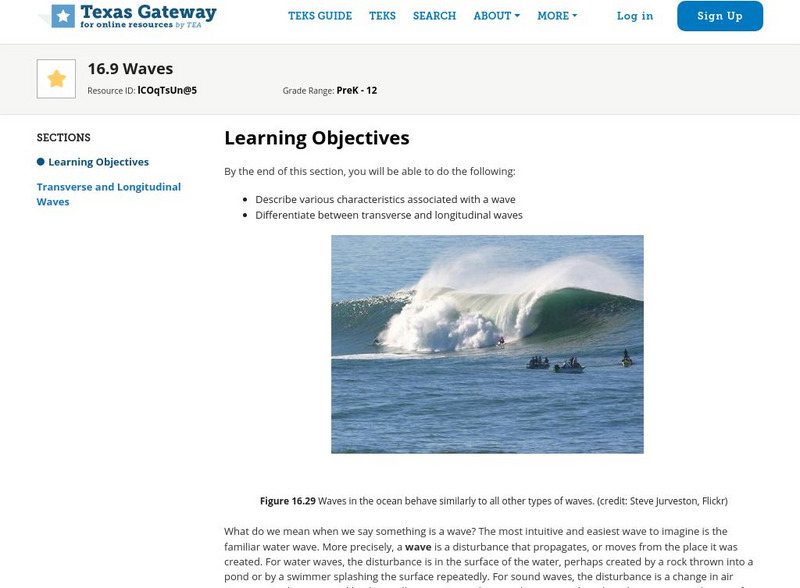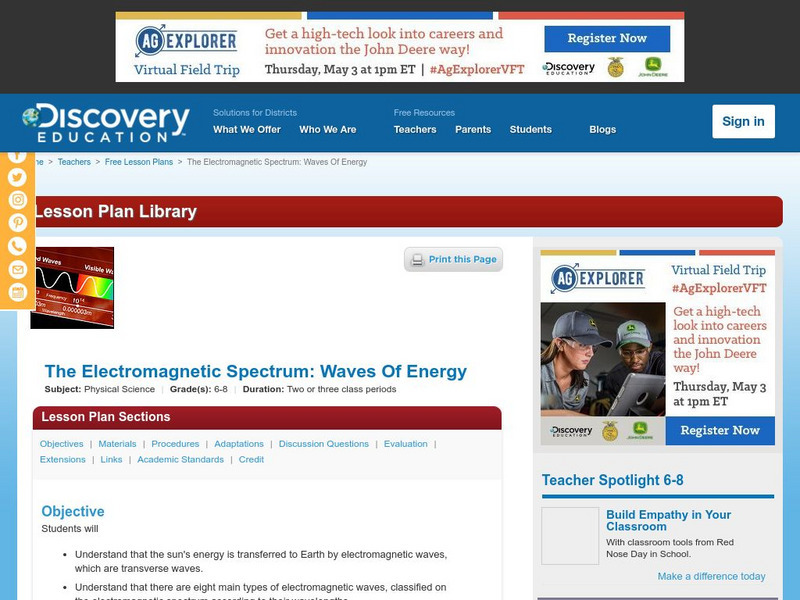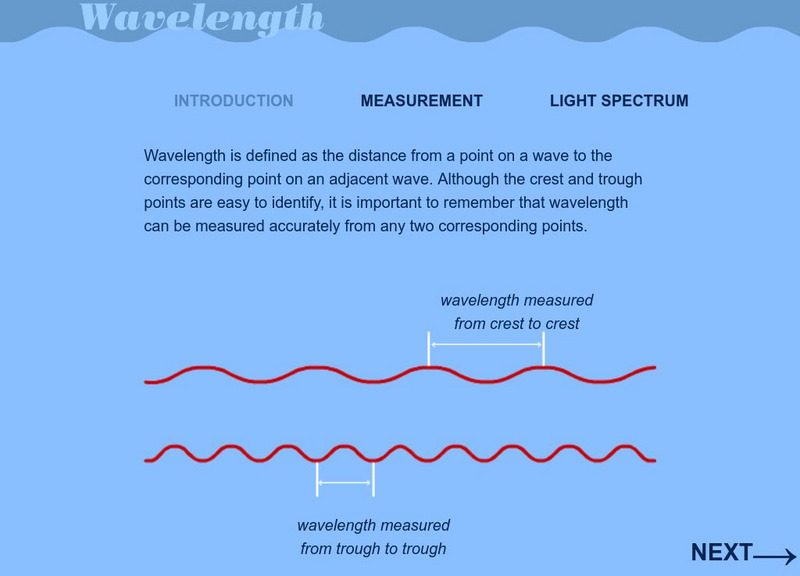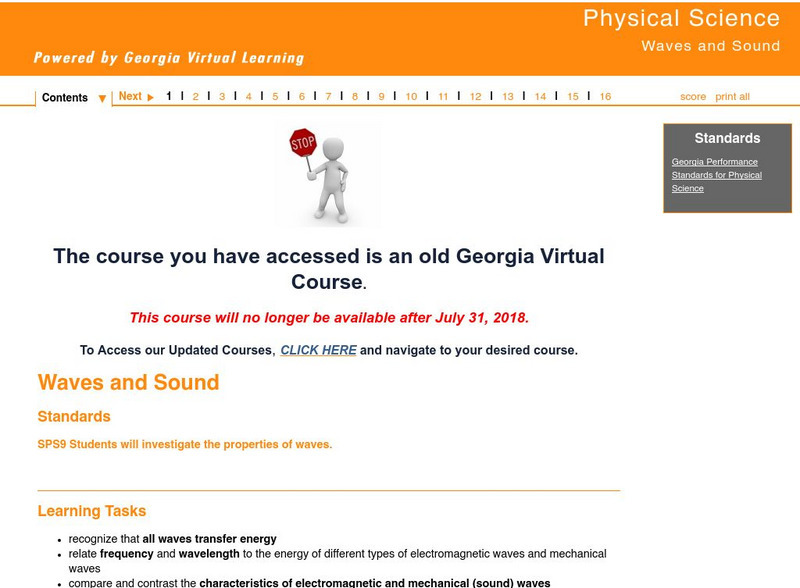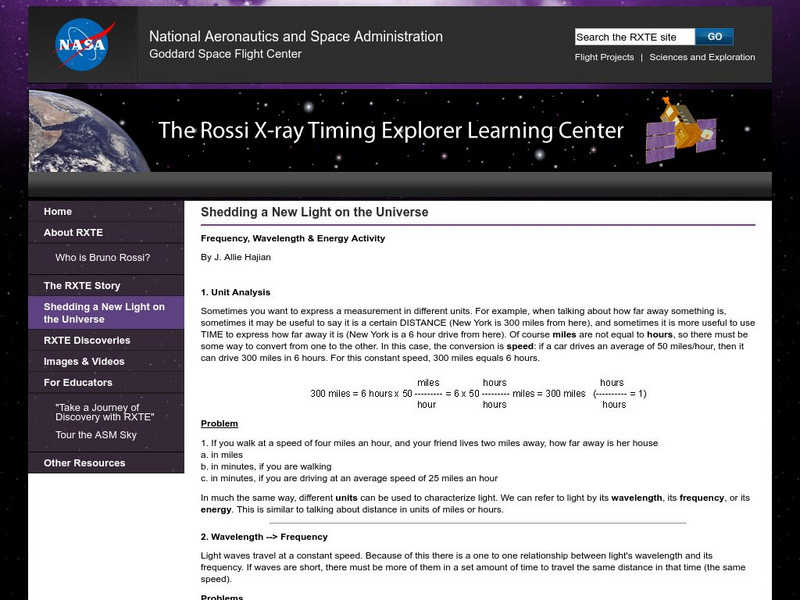Vision Learning
Vision Learning: Physics: Waves and Wave Motion
Instructional module focusing on waves and wave motion. Discussion includes wave theories, wave basics, and wave speed. The site also includes an interactive practice quiz and links relating to the topic.
Georgia Department of Education
Ga Virtual Learning: Ap Physics 1: Waves and Sound
Students will understand and predict wave phenomena, and investigate the energy contained in waves. They will gain a deeper understanding of waves and wave interference that will enable characterization and engineering of matter from the...
CK-12 Foundation
Ck 12: Physical Science: Properties of Electromagnetic Waves
[Free Registration/Login may be required to access all resource tools.] The speed of electromagnetic waves, their wavelengths and frequencies and how to calculate wavelength or wave frequency.
PBS
Pbs Learning Media: Light Waves: Interactive Lesson
Light is all around you, with wavelengths bigger than mountains and smaller than atoms. Learn about light waves, and the ways in which light interacts with matter, with this lesson plan.
Physics Classroom
The Physics Classroom: Formation of Standing Waves
How are standing wave formations formed? Why are they only formed when the medium is vibrated at specific frequencies? What makes these so-called frequencies so special and magical? These questions are answered in this exploration of...
Texas Education Agency
Texas Gateway: Oscillatory Motion and Waves: Waves
By the end of this section, you will be able to describe various characteristics associated with a wave and differentiate between transverse and longitudinal waves.
Discovery Education
Discovery Education: The Em Spectrum: Waves of Energy
Students are introduced to the electromagnetic spectrum through this group research activity. Each group investigates a different wavelength range within the em spectrum and reports back to class. Discussion ideas also included.
Physics Classroom
The Physics Classroom: Traveling Waves vs. Standing Waves
Traveling and standing waves are thoroughly explained through the use of drawings and animation.
PBS
Pbs Learning Media: Wavelength
Understand the method used to measure wavelength and how light waves are associated with colors based on wavelength.
BBC
Bbc: Gcse Bitesize: General Properties of Waves
Light travels as waves. Waves can be described by their amplitude, wavelength and frequency. The speed of a wave can be calculated from its frequency and wavelength.
TeachEngineering
Teach Engineering: Waves and Wave Properties
Students learn about the types of waves and how they change direction, as well as basic wave properties such as wavelength, frequency, amplitude and speed. During the presentation of lecture information on wave characteristics and...
CK-12 Foundation
Ck 12: Wave Speed Calculations
[Free Registration/Login may be required to access all resource tools.] Students investigate and analyze characteristics of waves, including velocity, and calculate the relationship between wave speed, frequency, and wavelength.
University of Colorado
University of Colorado: Physics 2000: Electromagnetic Waves
Using a student-teacher dialogue format, this page discusses the nature of light as an electromagnetic wave and the electromagnetic spectrum.
University of Colorado
University of Colorado: Ph Et Interactive Simulations: Fourier Making Waves
Learn how to make waves of all different shapes by adding up sines or cosines. Make waves in space and time and measure their wavelengths and periods. See how changing the amplitudes of different harmonics changes the waves. Compare...
University of Colorado
University of Colorado: Physics 2000: More About Visualizing Electromagnetic Waves
Discusses the nature of an electromagnetic wave. Explains the oscillating electric field and represents it through clever graphics and animations.
University of Colorado
University of Colorado: Physics 2000: Constructive and Destructive Wave Interference
A physics course web page that features a Java applet in which visitors can observe the waveform resulting from the interference of two waves. The amplitude and wavelength of the interfering waves can be altered and the outcome observed.
CK-12 Foundation
Ck 12: Electromagnetic Waves
[Free Registration/Login may be required to access all resource tools.] In this learning module, compare characteristics and behaviors of transverse waves, including electromagnetic waves.
Georgia Department of Education
Ga Virtual Learning: Physical Science: Waves and Sound
In this module, students investigate the properties and behavior of different types of waves.
CK-12 Foundation
Ck 12: Transverse Waves
[Free Registration/Login may be required to access all resource tools.] Explore the characteristics and behaviors of energy transferred by transverse waves.
Georgia State University
Georgia State University: Hyper Physics: Wave Motion
Two wave graphs depicting a sine wave and relating the various characteristics (wavelength, amplitude, frequency, and period) of a wave to each other. The site includes an interactive JavaScript form in which the visitor enters one...
NASA
Rxte Learning Center: Frequency, Wave Length, and Energy Activity
Resource focuses on the relationship between the frequency, wavelength and speed of light. Has a link to an interactive activity relating frequency, wavelength, and energy.
Florida State University
Florida State University: Basic Electromagnetic Wave Properties
This Florida State University page includes an interactive java tutorial that explores the relationship between frequency, wavelength, and energy, and enables the visitor to adjust the intensity of the radiation and to set the wave into...
CK-12 Foundation
Ck 12: Physical Science: Wavelength
[Free Registration/Login may be required to access all resource tools.] What wavelength is and how it relates to the energy of a wave.
Physics Classroom
The Physics Classroom: The Wave Equation
A thorough explanation of the wave equation (Speed = Wavelength * Frequency). A data table and questions to check one's understanding are also part of this lesson.

